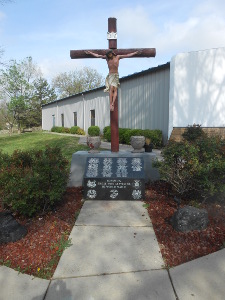 Civil War Veterans' graves
Civil War Veterans' graves Civil War Veterans' graves
Civil War Veterans' graves
Emporia, Kansas celebrated Veterans Day on 11 Nov 1953, a year before it became a federal highway. The Congressman from Emporia, Ed Rees, was the author of the bill changing Armistice Day to Veterans Day, a bill signed by the President from Abilene, Kansas, Dwight D. Eisenhower.
On the city map given to tourists are four war memorials. We decided to see them all.
The first was a graveyard of Civil War soldiers. Kansas fought on the Union side, although that wasn't certain at first. Free-Staters from New England and pro-slavery settlers from Missouri rushed into the territory, for the Constitution of the future state of Kansas would be determined by a vote of the settlers. Sounds like a recipe for warfare, doesn't it? Well, it was.
 Civil War Monument
Civil War Monument
There were four votes for statehood in Kansas, and some real claims of rigged elections were made each time. It is a historical fact that a certain number of Missourians crossed the border into Kansas and voted for slavery. But the fourth and final constitution declared the state a free state, even though Congress did not accept the new state until after the southern states had seceded from the Union.
So it's not surprising that the highest percentage of military volunteers from any state of the Union was from Kansas, and it's not surprising that some of the bloodiest battles occurred in Eastern Kansas, where Quantrill's Raiders came riding in. But most of the soldiers buried in the Civil War graveyard lived to attend many conventions of the G.A.R.
Next we found a large Civil War memorial in Fremont Park, put up by a local G.A.R. group and the city in 1913.
 Mexican American WW II Vets
Mexican American WW II Vets
The third memorial was in front of a Catholic Church on the south side of town, where most of the parishioners have Hispanic names. The plaque listed some 75 World War II Veterans from that Parish, and is identified on the map as a memorial to "Mexican-American Veterans of World War II." It reminded us of visits to English churches and cathedrals, which often have war memorials inside the church, celebrating the local veterans.
Finally, the largest and most elaborate was the All Veterans Memorial, which had many parts - flags for each war, ten large concrete stands each bearing names of 80 veterans in addition to up to eight large bronze plaques, a helicopter from Vietnam, a ship's anchor and another ship's bell. This large civic  Emporia All Veterans Memorial
veterans' memorial is still a work in progress.
Emporia All Veterans Memorial
veterans' memorial is still a work in progress.
We had wondered why so many fields around Emporia were blackened. It turns out that Emporia is in the Tallgrass Prairie, where ancient prairie grasses still grow naturally; to prevent the invasive species from wiping out the native grasses, the local ranchers all burn their pastures each spring. The hotel clerk thought it was too stinky (which it is!)
It seems strange to us that Emporia is where William Allen White, the editor and publisher of the Emporia Gazette, became a leader of the Progressive wing of the Republican Party, supporting Theodore Roosevelt and the League of Nations, yet the modern Kansas of Sam Brownback is almost synonymous with ultra-right-wing politics and hatred of government.